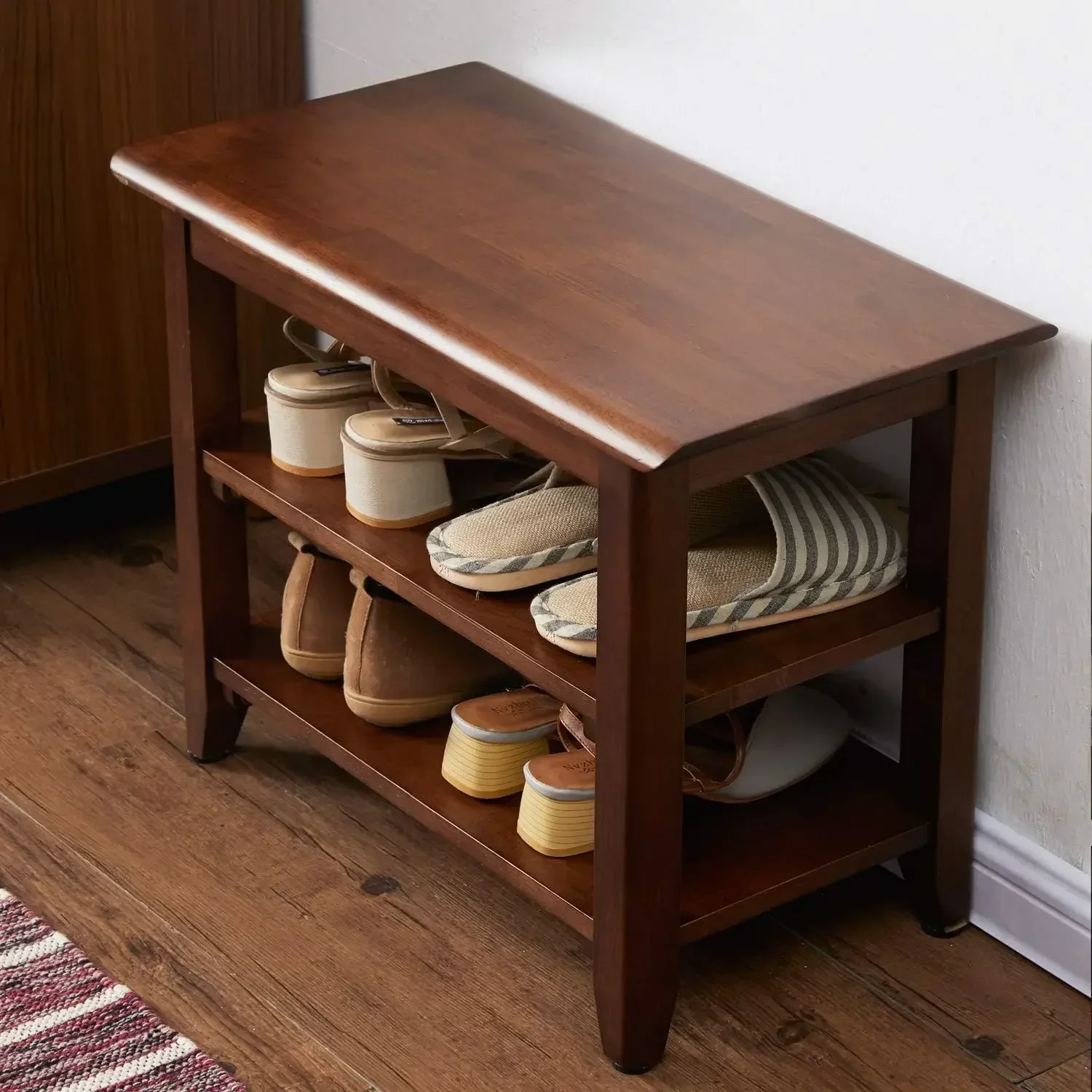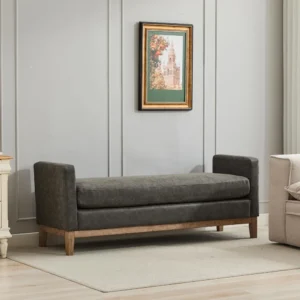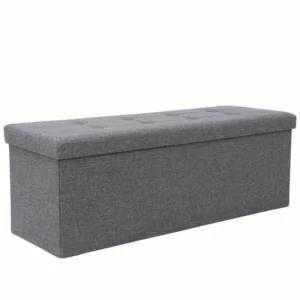The Front Door Bench: More Than Just a Seat
When you step into a home, that first piece of furniture you encounter often plays a crucial role in both function and style. But what exactly do you call that bench at the front door? Common names include entryway bench, foyer bench, hall bench, and mudroom bench – each with subtle differences in purpose and design.
These versatile pieces serve as much more than simple seating. They create a practical pause point while simultaneously establishing the style tone for your entire home. The terminology varies based on specific location (entryway vs. mudroom), features (storage vs. simple seating), and design elements (rustic vs. modern).
Different homes naturally have different entryway needs. A compact apartment might benefit from a space-conscious hall bench with vertical storage, while a spacious suburban home might showcase a grand foyer bench with decorative elements. Understanding the various space-saving solutions for entryways helps homeowners make more informed decisions about these essential pieces.
Whether you’re looking to add functionality to a busy family entrance or create a stylish first impression for guests, the right entryway bench can transform your home’s entrance from a simple passageway into a thoughtfully designed transition space. Let’s explore the complete range of front door bench options to find your perfect match.
Understanding the Terminology: A Complete Guide to Front Door Bench Types
Entryway Bench
An entryway bench serves as the catch-all term for any bench positioned near a home’s main entrance. These versatile pieces typically sit directly inside the front door, creating an immediate functional spot for sitting, dropping bags, or removing shoes. The beauty of entryway benches lies in their adaptability – they range from simple wooden benches to elaborate storage solutions.
Most entryway benches measure between 36-48 inches wide and 16-18 inches deep, providing enough space for practical use without overwhelming the entry area. Materials vary widely from solid wood and engineered wood to metal frames with upholstered seats, allowing these pieces to complement virtually any home style. For smaller spaces, size-appropriate bench options ensure even compact entries can benefit from this functional furniture.
Foyer Bench
Foyer benches specifically address the needs of more formal or spacious entrance halls. Unlike general entryway benches, foyer benches typically feature more decorative elements and substantial construction, often serving as statement pieces in addition to their functional role.
These benches frequently take a central or prominent position in larger entryways, creating a focal point that sets the tone for your home’s overall aesthetic. Materials tend toward the luxurious side – hardwoods with detailed craftsmanship, elegant upholstery, or distinctive metal work. Foyer benches often pair beautifully with other entrance hall furniture like console tables or dramatic mirrors to create a cohesive, welcoming space.
Hall Bench / Hallway Bench
Hall benches or hallway benches feature narrower profiles specifically designed for corridor spaces where depth is limited. Their slimmer dimensions (typically 12-15 inches deep) allow comfortable seating without impeding traffic flow in these transitional areas.
These space-conscious pieces typically position against walls to maximize available walking space while providing convenient stopping points. Many hall benches incorporate vertical storage elements like hooks or tall backrests to utilize wall space efficiently while keeping the footprint minimal – perfect for homes where every square inch matters.
Mudroom Bench
Mudroom benches prioritize high functionality for casual, high-traffic entry zones. These durable workhorses emphasize practical features over decorative elements, though many modern designs beautifully blend both aspects.
Typically placed in secondary entrances or utility spaces, mudroom benches focus on robust construction and easy-clean materials like metal, laminate, or treated wood that stand up to dirt, moisture, and heavy use. Their defining characteristic is enhanced storage functionality – boot trays to contain debris, coat hooks for outerwear, and cubbies for outdoor gear. For homes with active families or outdoor enthusiasts, specialized mudroom bench solutions provide organized containment for all the elements that would otherwise create clutter.
Shoe Bench / Storage Bench
Shoe benches or storage benches feature dedicated organizational elements designed specifically for footwear and other entrance essentials. These practical pieces solve the perennial problem of entry clutter through thoughtful design.
The storage configurations vary widely – open shelves for frequently used shoes, closed cabinets for seasonal items, drawers for accessories, or lift-top compartments for hidden storage. A typical shoe bench might accommodate 6-12 pairs depending on design, with some specialized versions including ventilation features to prevent odor buildup. For homes where shoe organization presents a particular challenge, dedicated shoe storage benches provide tailored solutions that combine seating with systematic organization.
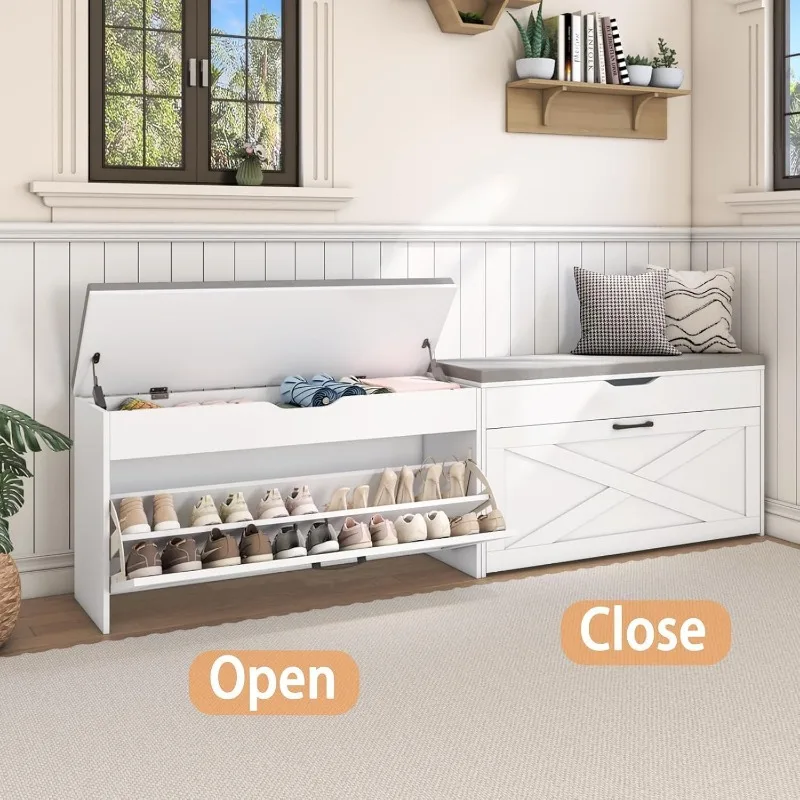
Hall Tree (with Bench)
Hall trees combine seating with vertical storage in all-in-one solutions that maximize functionality in limited space. These comprehensive pieces typically feature a bench with coat hooks above, often accompanied by a mirror, upper shelf, or additional storage elements.
Drawing design inspiration from Victorian-era hall trees but updated for modern needs, these pieces typically stand 72-80 inches tall, creating an instant entry station that addresses multiple organizational needs at once. The bench component provides seating while the vertical elements efficiently use wall space for hanging coats, storing accessories, and sometimes even displaying decorative items. For homes seeking complete entryway solutions, hall trees with integrated bench seating offer the ultimate in space-efficient organization.
Accent Bench
Accent benches prioritize aesthetic appeal alongside functionality, often featuring distinctive design elements that make them conversation pieces in their own right. These style-forward options may offer less storage capacity but compensate with stronger design statements.
Materials often include attention-grabbing elements like boucle fabrics, velvet upholstery, or artistic metalwork that elevate the piece beyond simple utility. Placed as focal points in entryways, accent benches create immediate visual impact while still providing practical seating. These pieces work particularly well in homes where the entryway has sufficient alternative storage options, allowing the bench to function more as a design element.
Porch Bench / Outdoor Entry Bench
Porch benches or outdoor entry benches feature weather-resistant construction for placement outside the front door. These transitional pieces create a welcoming pause point before entering the home.
Materials focus on durability in the elements – teak, cedar, powder-coated metal, or resin components that withstand exposure while maintaining their appearance. Typically positioned on covered porches or protected entry areas, these benches facilitate the transition between outdoor and indoor spaces, providing a spot to remove muddy boots or set down packages before entering. Maintenance requirements vary based on climate conditions and exposure levels, with some materials requiring seasonal treatments to maintain their appearance.
Why Every Home Benefits from an Entryway Bench
A Practical Pause Point
An entryway bench creates a designated spot for those essential coming-and-going moments that punctuate daily life. This practical pause point serves as a comfortable place to sit while putting on or removing shoes, waiting for family members, or gathering last-minute items before heading out.
For households with elderly members or those with mobility concerns, having a stable seating option at entry points becomes particularly valuable, eliminating the awkward balancing act of shoe changes. The bench essentially creates a smoother transition between indoor and outdoor activities, turning what could be a chaotic process into an organized routine. Many homeowners discover that implementing space-saving entryway ideas that include a bench dramatically improves their daily comings and goings.
Clutter Control Central
Entryway benches serve as the first line of defense against household chaos by providing immediate organization for items that might otherwise scatter throughout the home. With the right bench configuration, shoes find their proper place rather than creating tripping hazards, seasonal accessories get contained rather than lost, and everyday essentials stay accessible but controlled.
The storage strategy can adapt seasonally – accommodating bulky winter boots and accessories during colder months, then transitioning to summer sandals and beach gear when temperatures rise. Even the smallest items find their place, with many bench designs incorporating specific spots for keys, mail, dog leashes, and other easy-to-misplace items that typically enter the home with you.
Creating Powerful First Impressions
The psychological impact of a well-designed entry area extends far beyond simple organization. Your entryway bench sets the tone for your entire home’s aesthetic, creating an immediate impression for visitors and a welcome-home moment for residents.
Different bench styles telegraph different messages – a sleek, minimal design suggests contemporary sophistication, while a rustic wood bench with hooks creates a casual, farmhouse feeling. The right bench helps establish this tone without saying a word. Design psychology research consistently shows that organized, intentional entryways create positive impressions and reduce stress levels for both residents and guests, making this small area disproportionately important to overall home satisfaction.
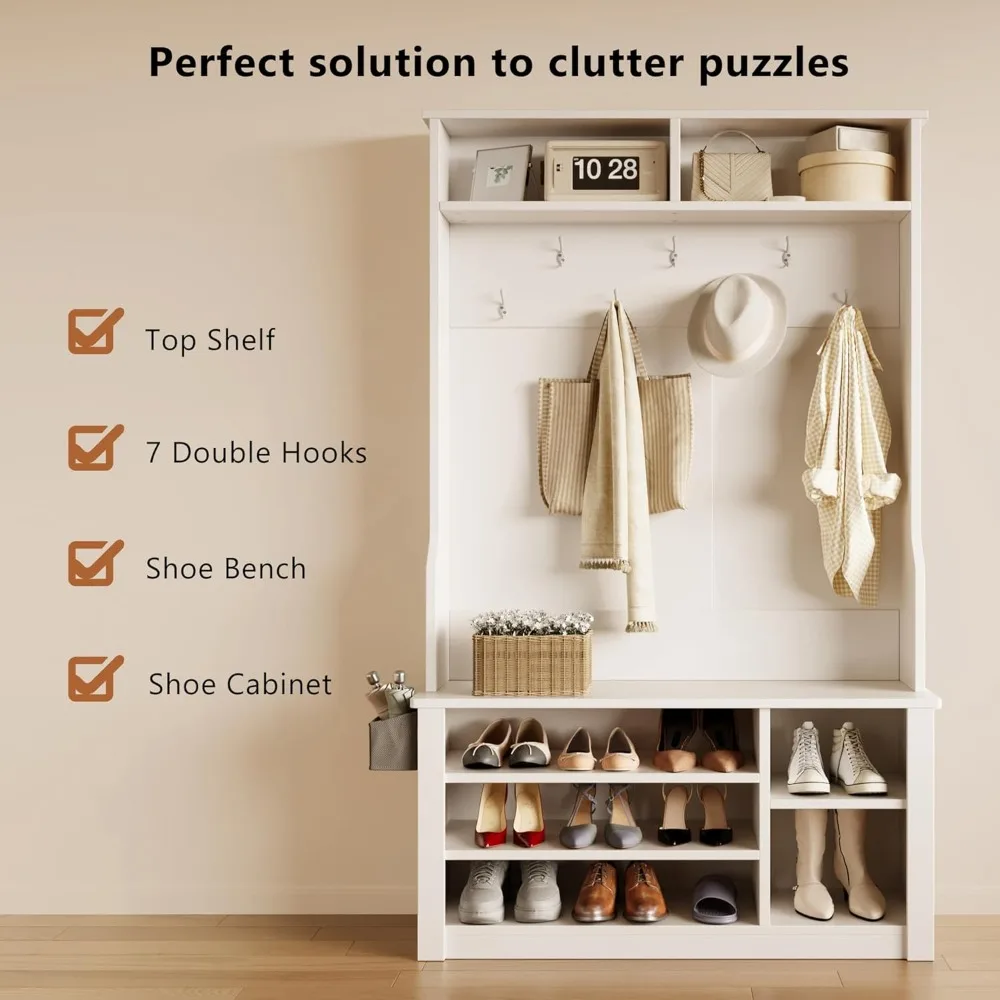
Defining Transitional Spaces
In homes with open floor plans or undefined entryways, benches help create visual boundaries that define the transition from outside to inside. This furniture-defined architecture creates subtle cues about movement through the space without requiring walls or permanent fixtures.
Even in smaller apartments where square footage comes at a premium, a thoughtfully selected bench anchors the entry area and creates a sense of arrival. Many homeowners find that understanding the essential features to consider in hall tree benches helps them select pieces that maximize both function and spatial definition. The bench essentially becomes an architectural element that shapes how people experience the home from the moment they step through the door.
Finding Your Perfect Match: How to Choose the Right Entryway Bench
Space Considerations
Before falling in love with any entryway bench, accurate space measurement becomes your most important first step. Start by measuring the available width where the bench will sit, then ensure you’ll have at least 36 inches of clearance for comfortable passage around the piece. Standard entryway benches typically stand 17-19 inches high (optimal sitting height) and extend 15-18 inches deep from the wall.
For proper proportion, a good rule of thumb suggests your bench width should be approximately 1/2 to 2/3 the width of the wall where it will sit. This creates balanced visual weight without overwhelming the space. In particularly tight entries, consider a corner design that maximizes seating while minimizing the footprint. Many homeowners with limited space benefit from learning how to organize small entryways with bench solutions that maximize every available inch.
Lifestyle Assessment
The perfect bench for your home directly reflects how your household actually lives. Families with children might prioritize robust storage options for multiple backpacks, sports equipment, and the inevitable collection of shoes that accumulates at the door. Urban professionals might focus more on slim profiles with specific organization for keys, mail, and work accessories.
Consider who will use the bench regularly – households with elderly members or those with mobility concerns benefit from sturdy construction with arms for support when sitting and standing. Homes with pets might select materials that resist scratches and are easily cleaned. The bench should align with your actual daily patterns rather than an idealized version of home life, ensuring it becomes a helpful tool rather than an underutilized decoration.
Style Harmony
Your entryway bench doesn’t exist in isolation – it establishes the first visual impression of your interior style. The most successful choices coordinate with your existing decor through complementary materials, colors, and design language.
Material selection balances both aesthetic and practical concerns. Wood offers warmth and timeless appeal but requires consideration of existing wood tones in your home. Metal provides modern durability but can feel cold without softening elements. Upholstered options add comfort and color opportunities but demand more maintenance in high-traffic areas.
For color selection, neutrals offer the greatest versatility, while statement colors create immediate visual impact but limit future decor changes. The bench should feel like an intentional extension of your overall design approach, creating a cohesive introduction to your home’s complete aesthetic story.
Key Features to Consider: Breaking Down Your Options
Storage Configurations
The storage design of your entryway bench dramatically impacts both its functionality and visual presence in your space. Open storage (shelves or cubbies) offers immediate accessibility and visual reminders of what’s stored, making it ideal for frequently used items. Closed storage (cabinets, drawers, or lift-tops) creates a cleaner appearance by concealing contents but requires an extra step for access.
Different configurations serve distinct purposes – drawers excel for small items that tend to create visual clutter, lift-tops provide deep storage for bulky seasonal items, cubbies create designated spaces for individual family members, and shelves offer the most efficient use of space for shoes and boots. The ideal entryway bench storage solution balances your specific organizational needs with the aesthetic impact you want the piece to have in your space.
Seating Comfort
While storage often dominates the conversation around entryway benches, seating comfort deserves careful consideration for pieces that will see daily use. Backless designs offer the most flexibility for placement and typically take up less visual space, while backed benches provide more support for extended sitting but require wall placement.
Seat depth between 15-18 inches generally provides comfortable seating for most adults. Cushioning options range from minimal (hardwood with thin pads) to substantial (thick foam or memory foam with upholstery). The right balance depends on how long people typically sit on the bench – brief shoe changes require less cushioning than waiting areas where guests might spend several minutes. Consider materials that resist compression over time while maintaining their appearance despite frequent use.
Material Selection
Your material choice determines not just how the bench looks but how it performs over years of daily use. Solid wood offers timeless durability with each species bringing distinct characteristics – oak provides exceptional strength with prominent grain patterns, while pine offers affordability with a casual appearance. Engineered woods provide cost advantages but typically show wear more quickly at edges and high-contact points.
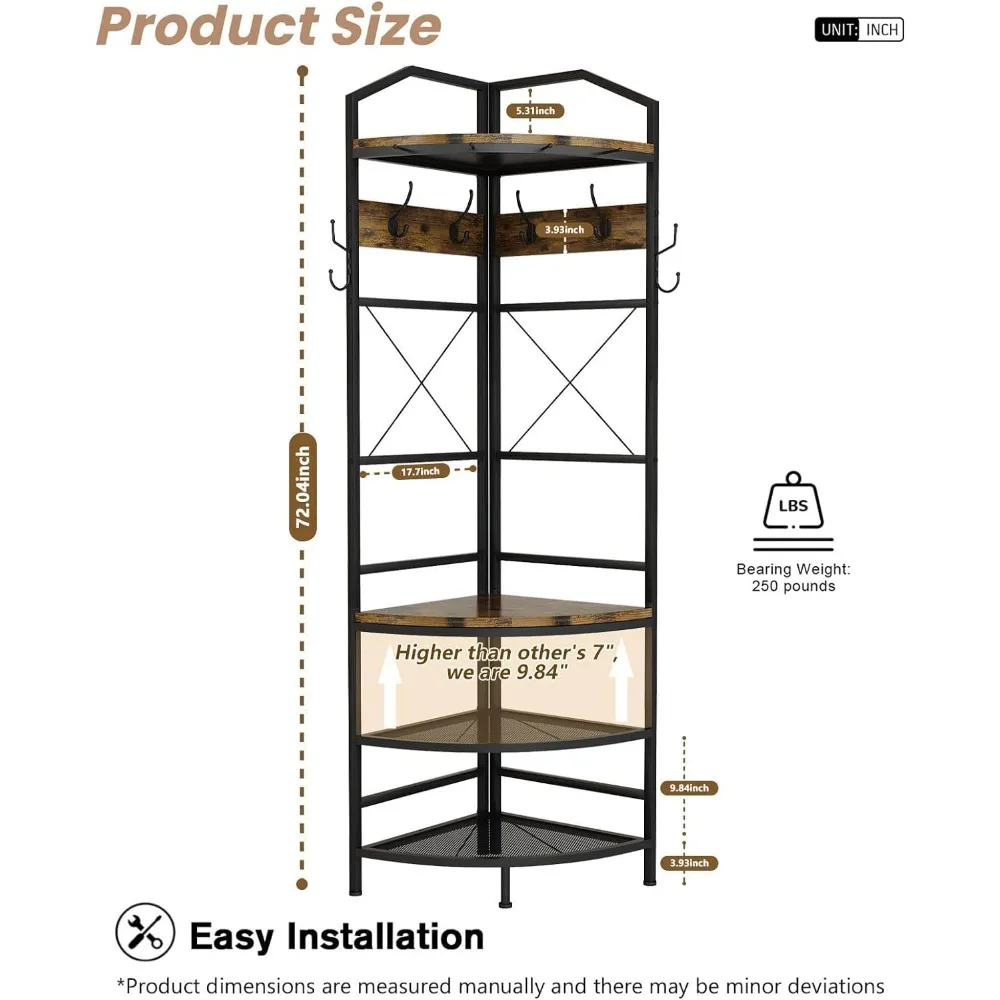
For upholstered elements, fabric selection significantly impacts longevity. Look for materials with high rub counts (15,000+ for residential use) and stain-resistant treatments for high-traffic areas. Performance fabrics developed specifically for heavy use often provide the best combination of appearance and practicality for entryway applications.
Each material carries specific maintenance requirements – wood may need occasional polishing or refinishing, metals require checking for rust or loose connections, and fabrics benefit from regular vacuuming and prompt stain treatment. The right choice balances your aesthetic preferences with your willingness to perform necessary maintenance over the bench’s lifetime.
Entryway Bench with Cushion, Mudroom Bench with Cushion, Shoe Bench for Entryway
$1,186.63 Select options This product has multiple variants. The options may be chosen on the product pageCoat Rack Shoe Bench, Corner Entryway Bench, Corner Hall Tree, Shoe Bench for Entryway
$313.58 Select options This product has multiple variants. The options may be chosen on the product pageEntryway Bench with Back, Modern Entryway Bench, Shoe Bench for Entryway
Price range: $463.13 through $474.44 Select options This product has multiple variants. The options may be chosen on the product pageShoe Storage Bench for Entryway
$459.02 Select options This product has multiple variants. The options may be chosen on the product pageEntryway Bench with Shelf Storage, Shoe Bench for Entryway, Shoe Storage Bench
$194.08 Select options This product has multiple variants. The options may be chosen on the product pageCorner Entryway Bench, Entryway Bench with Cushion, Modern Entryway Bench, Shoe Bench for Entryway
$476.34 Select options This product has multiple variants. The options may be chosen on the product page
Styling Your Entryway Bench: Creating a Cohesive Look
Transforming your entryway bench from purely functional to visually striking involves thoughtful coordination with surrounding elements. The wall space above the bench offers prime decorative real estate – hang a mirror to create the illusion of more space while providing a quick appearance check before heading out, or display artwork that establishes your home’s color palette and style direction.
Textiles add both comfort and visual interest – layer a bench cushion in a durable fabric with seasonal throw pillows that can be easily changed for refreshed looks throughout the year. Scale matters in these accessories – a bench under 48 inches wide typically looks best with just one or two pillows to avoid a cluttered appearance.
The vertical space deserves equal attention through proper proportion. As a general guide, wall art above a bench should be approximately 2/3 to 3/4 the width of the bench below it to create visual balance. Lighting placement – whether wall sconces flanking artwork or a small table lamp on one end of the bench – adds both functionality and ambiance to the entryway vignette.
Storage accessories can simultaneously solve organizational needs and enhance style – woven baskets beneath an open bench corral smaller items while adding texture, decorative trays on the bench surface contain keys and mail while adding a touch of personality. These thoughtful styling elements transform a purely practical piece into a design statement that sets the tone for your entire home.
Maintenance Made Simple: Keeping Your Entryway Bench Looking Its Best
Different bench materials require specific care approaches to maintain their appearance and functionality. For wood surfaces, dust regularly with a soft cloth and address spills immediately to prevent staining. Periodically apply an appropriate wood cleaner and conditioner (following grain direction) to maintain luster and prevent drying or cracking. Avoid placing wood benches in direct sunlight or near heating vents where excessive drying can occur.
Upholstered elements benefit from weekly vacuuming to prevent dirt from settling into fibers. Address spills immediately by blotting (never rubbing) with clean cloths, and consider applying fabric protector sprays designed for furniture. For stubborn stains on washable covers, follow manufacturer instructions for removal and cleaning.
Metal components should be checked periodically for loose connections and wiped clean with appropriate metal cleaners. Address any rust spots immediately on non-stainless components to prevent spreading.
Establishing a quick daily reset routine – returning items to their designated places, wiping down high-touch surfaces, and straightening cushions or accessories – prevents the gradual disorganization that can overwhelm entryway spaces. Seasonal deep cleaning provides opportunities to rotate stored items, check for needed repairs, and refresh the space with updated accessories that reflect the changing seasons.
Your Entryway, Elevated: Finding the Perfect Bench for Your Home
Whether you call it an entryway bench, foyer bench, mudroom bench, or hall tree, the right piece at your front door serves as both functional workhorse and style statement. By understanding the subtle differences between these furniture types, you can select the option that best addresses your specific space constraints, organizational needs, and design preferences.
The perfect entryway bench creates that elusive balance between practicality and beauty – providing the organizational features your household requires while establishing a welcoming first impression that sets the tone for your entire home. Consider how your bench will function within your daily routines, the space available for placement, and the aesthetic statement you want to make.
With thoughtful selection and styling, your entryway bench becomes much more than simple seating – it transforms into the foundation of an organized, welcoming home entrance that makes coming and going a pleasure rather than a chore. The right bench doesn’t just occupy space in your entryway; it actively improves how your home functions and feels from the moment you step through the door.

